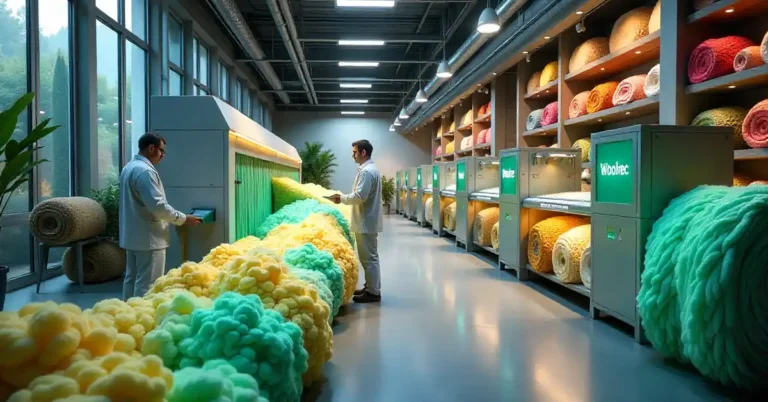Imagine a material that not only enhances efficiency but also adapts seamlessly to a variety of industries, from construction to electronics. Sinkom is gaining attention for exactly that kind of versatility. Whether you’re an engineer, a designer, or simply curious about innovative materials, understanding Sinkom’s benefits and applications can open up new possibilities.
What Is Sinkom?
Sinkom is a composite material known for its unique combination of strength, flexibility, and thermal resistance. It’s engineered by blending synthetic polymers with natural fibers, resulting in a product that’s lightweight yet incredibly durable. This blend allows Sinkom to outperform traditional materials like pure plastics or metals in many contexts. The versatility of Sinkom makes it suitable for a wide array of applications, ranging from high-performance sports equipment to everyday household items, showcasing its adaptability in various sectors.
Its production process involves advanced layering techniques that create a microstructure optimized for stress distribution. This means Sinkom can absorb shocks and resist deformation better than many conventional materials. The exact composition can be tailored depending on the intended use, making it highly customizable. For instance, by adjusting the ratio of natural fibers to synthetic polymers, manufacturers can enhance specific properties such as tensile strength or thermal insulation, allowing for innovative designs that meet precise performance criteria.
Origins and Development
Sinkom was initially developed for aerospace applications, where materials must withstand extreme conditions without adding unnecessary weight. Over time, researchers realized its potential beyond aerospace, leading to adaptations for automotive, construction, and even consumer electronics industries. The aerospace sector’s rigorous standards for safety and performance served as a testing ground, ensuring that Sinkom could meet the demands of high-stakes environments. This rigorous testing has contributed to its reputation as a reliable material in various high-performance applications.
Its evolution reflects a broader trend toward sustainable materials. By incorporating natural fibers, Sinkom reduces reliance on purely synthetic components, which helps lower environmental impact during production and disposal. This focus on sustainability resonates with modern consumers who are increasingly aware of the environmental implications of their choices. Additionally, the use of renewable resources in Sinkom’s composition not only enhances its eco-friendliness but also contributes to a circular economy, as these materials can often be recycled or repurposed at the end of their lifecycle. As industries continue to prioritize sustainability, Sinkom stands out as a forward-thinking solution that aligns with these values, paving the way for a more responsible approach to material science.
Key Benefits of Sinkom
Strength and Durability
One of Sinkom’s standout features is its impressive strength-to-weight ratio. It can handle heavy loads and resist wear and tear, making it ideal for structural components. Unlike metals that may corrode or plastics that might crack under stress, Sinkom maintains integrity over long periods, even in harsh environments.
This durability translates to longer lifespans for products made with Sinkom, reducing the need for frequent replacements and repairs. For industries focused on cost efficiency and sustainability, this is a significant advantage. Furthermore, the resilience of Sinkom contributes to safety in applications such as construction and automotive manufacturing, where material failure can have severe consequences. By ensuring that structures and components remain intact under stress, Sinkom plays a critical role in enhancing overall safety standards.
Thermal and Chemical Resistance
Sinkom excels in resisting heat and chemicals, which broadens its usability. It can operate effectively in high-temperature settings without losing strength or deforming. This makes it suitable for engine parts, heat shields, and even kitchenware.
Its chemical resistance means Sinkom doesn’t degrade easily when exposed to oils, solvents, or acids. This property is particularly valuable in industrial environments where exposure to harsh substances is common. In sectors like pharmaceuticals and food processing, where hygiene and safety are paramount, Sinkom’s ability to withstand aggressive cleaning agents without deteriorating ensures compliance with stringent industry regulations. This reliability not only enhances product safety but also reduces downtime associated with maintenance and replacement.
Lightweight and Flexible
Despite its strength, Sinkom is surprisingly lightweight. This characteristic is crucial in transportation sectors where reducing weight improves fuel efficiency and performance. Additionally, Sinkom’s flexibility allows it to absorb impacts and vibrations, protecting sensitive components and enhancing user comfort.
Flexibility also means Sinkom can be molded into complex shapes without compromising its structural integrity, offering designers more freedom to innovate. This adaptability is particularly advantageous in the aerospace and automotive industries, where customized parts are often needed to optimize performance. The ability to create intricate designs not only enhances functionality but also allows for aesthetic considerations, enabling manufacturers to produce visually appealing products that do not sacrifice strength or durability.
Eco-Friendly Attributes
Incorporating natural fibers not only boosts Sinkom’s mechanical properties but also makes it more environmentally friendly. These fibers are renewable and biodegradable, reducing the material’s carbon footprint.
Moreover, Sinkom’s durability means fewer resources are consumed over time, as products last longer and generate less waste. Some manufacturers are also exploring recycling methods to recover and reuse Sinkom components, pushing sustainability even further. This innovative approach not only aligns with global sustainability goals but also appeals to environmentally conscious consumers who are increasingly seeking products that contribute to a healthier planet. By choosing Sinkom, companies can enhance their brand image as leaders in sustainability, attracting a growing market segment that prioritizes eco-friendly practices.
Common Uses of Sinkom
Construction and Building Materials
Sinkom is increasingly popular in construction due to its strength and resistance to environmental stressors. It’s used in panels, insulation, and structural supports where traditional materials might fail or require heavy maintenance.

Its thermal resistance helps improve energy efficiency in buildings by providing better insulation. Plus, its lightweight nature simplifies transportation and installation, cutting down labor costs and project timelines. Furthermore, Sinkom’s durability ensures that structures remain intact even in harsh weather conditions, reducing the need for frequent repairs and replacements. This longevity is particularly beneficial in regions prone to extreme temperatures or natural disasters, where building integrity is paramount.
Automotive Industry
Car manufacturers are turning to Sinkom for components like interior panels, bumpers, and under-the-hood parts. The material’s ability to withstand heat and chemical exposure makes it perfect for engine compartments and exhaust systems.
Reducing vehicle weight with Sinkom parts contributes to better fuel economy and lower emissions. Additionally, its impact absorption enhances passenger safety during collisions. As the automotive industry shifts towards sustainability, Sinkom’s recyclability adds another layer of appeal, allowing manufacturers to meet eco-friendly standards while still delivering performance. Moreover, the versatility of Sinkom allows for innovative designs that can enhance both aesthetics and functionality in modern vehicles, appealing to a growing market of environmentally conscious consumers.
Electronics and Consumer Goods
In electronics, Sinkom is used for casings and protective covers. Its flexibility and shock resistance protect delicate components from damage, extending device lifespans.
Consumer goods such as sports equipment, furniture, and kitchen tools also benefit from Sinkom’s properties. Products are lighter, more durable, and often more comfortable to use. The material’s resistance to wear and tear means that items can withstand daily use without showing signs of damage, making them a favorite among manufacturers aiming for longevity in their product lines. Additionally, the ability to mold Sinkom into various shapes allows for ergonomic designs that enhance user experience, making it a sought-after choice in both high-end and everyday consumer products. As trends shift towards minimalism and functionality, the use of Sinkom in design continues to grow, promising a future filled with innovative applications across diverse markets.
Innovative Applications and Future Potential
Medical Devices
Sinkom’s biocompatibility and flexibility make it a promising material for medical devices. It can be used in prosthetics, braces, and surgical instruments that require both strength and patient comfort.
Its resistance to sterilization chemicals ensures that medical tools remain safe and effective after repeated use.
Renewable Energy Sector
Wind turbine blades and solar panel components are areas where Sinkom’s lightweight and durable nature can make a real difference. Reducing the weight of turbine blades improves efficiency and reduces mechanical stress, leading to longer operational life.
In solar panels, Sinkom’s resistance to weathering helps protect sensitive parts from environmental damage, boosting energy output consistency.
Sports and Recreation
From bicycles to protective gear, Sinkom is making waves in sports equipment manufacturing. Its shock-absorbing qualities reduce injury risks, while its lightness enhances athlete performance.
Manufacturers are experimenting with Sinkom to create gear that adapts to different sports conditions, offering both protection and mobility.
Challenges and Considerations
Despite its many advantages, Sinkom is not without challenges. Production costs can be higher than traditional materials, especially when specialized fibers or manufacturing processes are involved.

Additionally, recycling Sinkom composites requires more advanced techniques compared to pure plastics or metals. This can limit its adoption in industries with strict recycling mandates.
However, ongoing research aims to address these issues by developing cost-effective production methods and improving recyclability. As these hurdles are overcome, Sinkom’s adoption is expected to grow significantly.
How to Choose Sinkom for Your Project
When considering Sinkom, it’s important to evaluate the specific requirements of your application. Factors like load-bearing needs, environmental exposure, and desired lifespan will influence the ideal Sinkom formulation.

Working with suppliers who offer customization and technical support can ensure you get the right material for your project. Testing prototypes under real-world conditions is also crucial to confirm performance before full-scale production.
Ultimately, Sinkom is a versatile option that can provide long-term value when selected and applied thoughtfully.
Conclusion
Sinkom represents a leap forward in material science, combining strength, flexibility, and sustainability in one package. Its growing use across industries highlights its adaptability and potential to improve product performance and durability.
Whether in construction, automotive, electronics, or emerging fields like medical devices and renewable energy, Sinkom offers solutions that meet modern demands. Understanding its benefits and challenges helps businesses and innovators make informed decisions, unlocking new opportunities for design and function.
Exploring Sinkom is more than just learning about a new material-it’s about embracing smarter, more sustainable ways to build the future.







